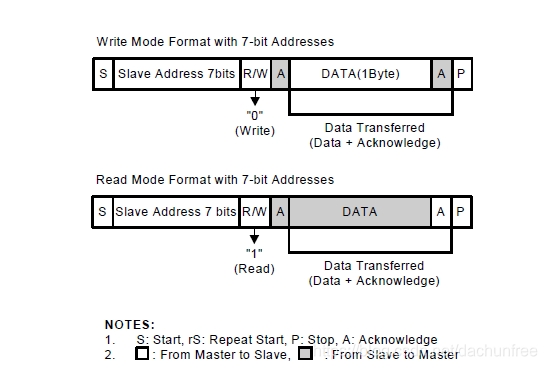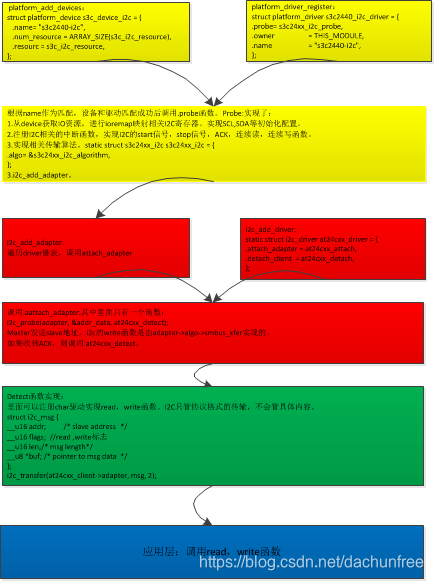1.环境
软件基于linux 2.2.26。硬件基于s3c2440。
2.I2C协议
2条双向串行线,一条数据线SDA,一条时钟线SCL。 SDA传输数据是大端传输,每次传输8bit,即一字节。总线上每个设备都有自己的一个addr,共7个bit。

2.1开始传输和结束传输
开始信号:SCL为高电平时,SDA由高电平向低电平跳变,开始传送数据。
结束信号:SCL为高电平时,SDA由低电平向高电平跳变,结束传送数据。

2.2 写信号
1. Master发起START
2. Master发送I2C addr(7bit)和w操作0(1bit),等待ACK
3. Slave发送ACK
4. Master发送reg addr(8bit),等待ACK
5. Slave发送ACK
6. Master发送data(8bit),即要写入寄存器中的数据,等待ACK
7. Slave发送ACK
8. 第6步和第7步可以重复多次,即顺序写多个寄存器
9. Master发起STOP

2.3 读信号
读寄存器的标准流程为:
1.主发送I2Caddr(7bit)和 W操作1(1bit),等待ACK
2.从发送ACK
3.主发送reg addr(8bit),等待ACK
4. Slave发送ACK
5. 主发起START
6.主发送I2C地址(7bit)和 R操作1(1bit),等待ACK
7.从设备发送ACK
8.从设备发送数据(8bit),即寄存器里的值
9.Master发送ACK
10.第8步和第9步可以重复多次,即顺序读多个寄存器.。

3.I2C驱动分析
此linux版本没有设备树,而是引用了总线设备驱动模型
1.黄色的框是总线设备驱动模型,进行name匹配后,调用probe函数。
2.红色部分是实现I2C适配器和driver的调用,主要目的是实现master发送start信号,确定salve设备是否存在。
3.绿色部分是slave回ACK,此时可以实现后续的read,write操作。
4.蓝色部分表示用户空间操作。
此次最重要的就是paltform总线,probe函数里面实现的中断函数。里面实现了I2C是如何传输的。

4.代码
此代码基于AT24C**的eeprom代码。
1.需要理解msg这个重要结构体代表的含义。
#include <linux/kernel.h>
#include <linux/init.h>
#include <linux/module.h>
#include <linux/slab.h>
#include <linux/jiffies.h>
#include <linux/i2c.h>
#include <linux/mutex.h>
#include <linux/fs.h>
#include <asm/uaccess.h>
static unsigned short ignore[] = { I2C_CLIENT_END };
static unsigned short normal_addr[] = { 0x50, I2C_CLIENT_END }; /* 地址值是7位 */
/* 改为0x60的话, 由于不存在设备地址为0x60的设备, 所以at24cxx_detect不被调用 */
static unsigned short force_addr[] = {ANY_I2C_BUS, 0x60, I2C_CLIENT_END};
static unsigned short * forces[] = {force_addr, NULL};
static struct i2c_client_address_data addr_data = {
.normal_i2c = normal_addr, /* 要发出S信号和设备地址并得到ACK信号,才能确定存在这个设备 */
.probe = ignore,
.ignore = ignore,
//.forces = forces, /* 强制认为存在这个设备 */
};
static struct i2c_driver at24cxx_driver;
static int major;
static struct class *cls;
struct i2c_client *at24cxx_client;
static ssize_t at24cxx_read(struct file *file, char __user *buf, size_t size, loff_t * offset)
{
unsigned char address;
unsigned char data;
struct i2c_msg msg[2];
int ret;
/* address = buf[0]
* data = buf[1]
*/
if (size != 1)
return -EINVAL;
copy_from_user(&address, buf, 1);
/* 数据传输三要素: 源,目的,长度 */
/* 读AT24CXX时,要先把要读的存储空间的地址发给它 */
msg[0].addr = at24cxx_client->addr; /* 目的 */
msg[0].buf = &address; /* 源 */
msg[0].len = 1; /* 地址=1 byte */
msg[0].flags = 0; /* 表示写 */
/* 然后启动读操作 */
msg[1].addr = at24cxx_client->addr; /* 源 */
msg[1].buf = &data; /* 目的 */
msg[1].len = 1; /* 数据=1 byte */
msg[1].flags = I2C_M_RD; /* 表示读 */
ret = i2c_transfer(at24cxx_client->adapter, msg, 2);
if (ret == 2)
{
copy_to_user(buf, &data, 1);
return 1;
}
else
return -EIO;
}
static ssize_t at24cxx_write(struct file *file, const char __user *buf, size_t size, loff_t *offset)
{
unsigned char val[2];
struct i2c_msg msg[1];
int ret;
/* address = buf[0]
* data = buf[1]
*/
if (size != 2)
return -EINVAL;
copy_from_user(val, buf, 2);
/* 数据传输三要素: 源,目的,长度 */
msg[0].addr = at24cxx_client->addr; /* 目的 */
msg[0].buf = val; /* 源 */
msg[0].len = 2; /* 地址+数据=2 byte */
msg[0].flags = 0; /* 表示写 */
ret = i2c_transfer(at24cxx_client->adapter, msg, 1);
if (ret == 1)
return 2;
else
return -EIO;
}
static struct file_operations at24cxx_fops = {
.owner = THIS_MODULE,
.read = at24cxx_read,
.write = at24cxx_write,
};
static int at24cxx_detect(struct i2c_adapter *adapter, int address, int kind)
{
printk("at24cxx_detect\n");
/* 构构一个i2c_client结构体: 以后收改数据时会用到它 */
at24cxx_client = kzalloc(sizeof(struct i2c_client), GFP_KERNEL);
at24cxx_client->addr = address;
at24cxx_client->adapter = adapter;
at24cxx_client->driver = &at24cxx_driver;
strcpy(at24cxx_client->name, "at24cxx");
i2c_attach_client(at24cxx_client);
major = register_chrdev(0, "at24cxx", &at24cxx_fops);
cls = class_create(THIS_MODULE, "at24cxx");
class_device_create(cls, NULL, MKDEV(major, 0), NULL, "at24cxx"); /* /dev/at24cxx */
return 0;
}
static int at24cxx_attach(struct i2c_adapter *adapter)
{
return i2c_probe(adapter, &addr_data, at24cxx_detect);
}
static int at24cxx_detach(struct i2c_client *client)
{
printk("at24cxx_detach\n");
class_device_destroy(cls, MKDEV(major, 0));
class_destroy(cls);
unregister_chrdev(major, "at24cxx");
i2c_detach_client(client);
kfree(i2c_get_clientdata(client));
return 0;
}
/* 1. 分配一个i2c_driver结构体 */
/* 2. 设置i2c_driver结构体 */
static struct i2c_driver at24cxx_driver = {
.driver = {
.name = "at24cxx",
},
.attach_adapter = at24cxx_attach,
.detach_client = at24cxx_detach,
};
static int at24cxx_init(void)
{
i2c_add_driver(&at24cxx_driver);
return 0;
}
static void at24cxx_exit(void)
{
i2c_del_driver(&at24cxx_driver);
}
module_init(at24cxx_init);
module_exit(at24cxx_exit);
MODULE_LICENSE("GPL");





















 1359
1359

 被折叠的 条评论
为什么被折叠?
被折叠的 条评论
为什么被折叠?








